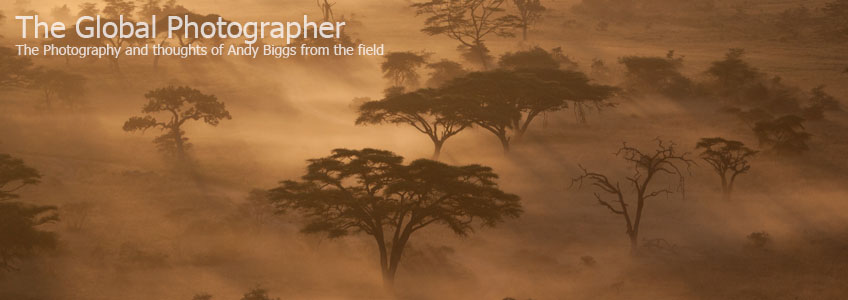Here are a few bullet points of technology changes or tests from my last Tanzania safari.
No Laptop
I attempted to spend 21 days out on safari without a laptop computer. In its place I used two Epson personal storage devices, the P-2000 and P-5000. I upgraded the P-2000 to 100GB, and the P-5000 had the standard 80GB drive inside.
Did the test work? Yes and no. It worked from a data storage standpoint, that's for sure. After each game drive I just plugged in the CF cards and walked away. Talk about simple. This freed up a ton of time to socialize, help other with their photos, talk about workflow, or just read a book. I did miss having a laptop around to critically review my images. When you start adding up the weight of two storage devices, you are approaching the weight of a subnotebook. The space required isn't that different, as well. I had my Epson storage devices protected with
Case Logic hard drive cases, and I cannot think of a better product to help protect these devices.

Two-headed Giraffe, Lake Manayara National Park, Tanzania, Oct 2007
Canon EOS 1DsMkII, 500mm f/4 + 1.4x, 1/1000 @ f/4
Digital ProjectorThis was my first safari with a digital projector, and this is the wave of the future for me. I do believe that our safari travelers enjoyed when I pulled out the projector for slideshows. I own the Epson 1705c LCD projector, and at 3.7 pounds it worked well for me. I look forward to the day when I can find a projector with increased resolution in a smaller package. The 1705c is a 1024x768 (XGA) projector. The colors are fantastic, and brightness and contrast is also great for small or large spaces.
Nikon D2x and 200-400mm f/4 I was having issues with the Canon EF 400mm f/4 DO IS with teleconverters, so I wasn't enthusiastic about using the lens once I figured out what was going on. A friend of mine from our first safari had to fork over 483 Pounds for his second checked bag out of Heathrow airport, so he was eager to have me take his Pelican case back to the US for him with some of his Nikon gear inside. US travelers are allowed two checked bags, instead of one. I am not sure why there is a difference, but it is what it is.
So suddenly I had a D2x, 200-400mm f/4 lens and a 1.7x teleconverter to use. He he. I haven't shot with a Nikon camera since 2002 when I switched to Canon. I enjoyed shooting with the D2x, as the ergonomics is top notch. Button placement is intuitive, usability is much easier than a Canon 1 series camera out of the box. To pick up the D2x and shoot with it is an exercise in not needing to read a manual. There are tons of menu choices, though, so it can be just as dizzying as my Canon cameras to understand everything you need to know.

Baby Giraffe, Serengeti National Park, Tanzania, Oct 2007
Nikon D2x, 200-400mm f/4, 1/200 sec @ f/4, ISO 800
I was disappointed with the image quality over ISO 400, though. I have become very spoiled with the image quality of my Canon cameras for higher ISO speeds, so this is a difficult hurdle for my shooting style. I am a depth of field junkie at times, so you might see me photograph with a long lens at f/11 to f/14 most of the time. F/8 is often used if I am suffering from a slow shutter speed. This has me using ISO 160 to 800 quite often on my own equipment, and I tried to avoid anything over ISO 400 on the D2x. This reminds me of my slide shooting days when I needed to be less sloppy and more regimented with my shooting style. From everything I hear, the new Nikon D3 should be a huge camera for those folks like myself that need to rely on higher ISO speeds.
The 200-400mm f/4 is a dream safari wildlife lens. I really did enjoy having the capability of zooming in and out to properly frame my images. The equivalent field of view with the lens is 300-600mm. I used the 1.7x teleconverter quite often with the lens, and even though the quality of the final image was quite good, the autofocus speed does suffer when not shooting in midday light. This was extremely disappointing, so my suggestion is to stick with the 1.4x teleconverter for faster autofocus speed.

Elephant Family, Serengeti National Park, Tanzania, Oct 2007
Canon EOS 1DsMkII, 500mm f/4, 1/500sec @ f/8, ISO 500
Garmin Vista Cx GPS device
How have I lived without a GPS device? GPS is very valuable for the safari photographer, and I was not only able to track where we went, I was also able to determine the elevation and mark waypoints. Battery life was less than optimal when I used rechargable AA batteries, as I averaged around 11 or 12 hours. On some days, we might be away from camp for the entire day, which could be 13 hours. 6am until 7pm. You never know. So I switched to lithium batteries to see if this changed. Talk about a huge change. I was able to get around 4 days per pair of lithium batteries, which averaged around 40 hours of use. The downside is that once depleted you need to throw the batteries away. So I carried all lithium batteries back home with me for disposal.
I used
LoadMyTracks to offload the data from the GPS unit to my Mac Pro desktop computer. You can save your files as .kml files for use with Google Earth. Very cool.
 Thursday, December 20, 2007 at 01:21PM
Thursday, December 20, 2007 at 01:21PM 















